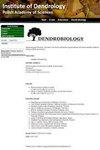Salinity stress effects on the growth, morphological, physiological, and biochemical properties of Melia (Melia dubia Cav.) plant
IF 1.8
4区 农林科学
Q2 FORESTRY
引用次数: 3
Abstract
Salinity stress severely affects the growth, physiological and developmental processes in plant species. Melia dubia is an ecologically and economically important tree species of the Indian subcontinent. However, systematic information with respect to the species salt tolerance potential is completely lacking. Under salt stress conditions, determining suitable soil EC range is required for the better survival, growth and productivity of the tree species. In present study, we investigated the effects of different soil salinity (EC 4, 8, and 12) levels on the ion homeostasis, physio-biochemistry, morphology, and growth of M. dubia plant. Results revealed that increase in soil salinity causes higher Na+ content and Na+/K+ ratio, while lower K+ content, in the leaf tissues of M. dubia. The physiological processes such as the photosynthetic rate, stomatal conductance, internal CO2 concentration, and transpiration rate were adversely affected with the increased salt stress levels. Morphological parameters, such as internodal length, petiole length, leaf length, and leaf width also decreased (P<0.05) under saline stress conditions. Results further indicated that salinity levels significantly (P<0.05) affected the M. dubia growth, and the growth rate was found optimum upto 8 EC, thereafter it slightly decreased with the increased salt stress to 12 EC. Our findings showed that increased salinity stress causes significant changes in the physiological, morphological, and growth pattern of M. dubia. Therefore, based on present experiment, we found M. dubia suitable for the salt affected soils of EC 8 with optimum growth rate and at EC 12 with the moderate (20–25%) growth reduction.盐度胁迫对苦楝(Melia dubia Cav.)植株生长、形态及生理生化特性的影响
盐度胁迫严重影响植物的生长、生理和发育过程。美利亚是印度次大陆的一种重要的生态和经济树种。然而,关于该物种耐盐潜力的系统信息完全缺乏。在盐胁迫条件下,确定适宜的土壤EC范围是提高树种生存、生长和生产力的必要条件。本文研究了不同土壤盐度(ec4、ec8和ec12)对杜鹃植物离子平衡、生理生化、形态和生长的影响。结果表明,土壤盐分的增加导致杜鹃叶片中Na+含量和Na+/K+比值升高,而K+含量降低。随着盐胁迫水平的升高,光合速率、气孔导度、内部CO2浓度和蒸腾速率等生理过程均受到不利影响。生理盐水胁迫下,叶柄长度、叶柄长度、叶长和叶宽均显著降低(P<0.05)。结果进一步表明,盐度水平显著(P<0.05)影响了杜鹃藻的生长,在8 EC时生长速度最佳,随后随着盐胁迫的增加,生长速度略有下降,直至12 EC。我们的研究结果表明,盐度胁迫的增加会导致杜比亚芽胞杆菌的生理、形态和生长模式发生显著变化。因此,在本试验的基础上,我们发现dubia适合于EC 8盐害土壤,生长速率最佳,EC 12盐害土壤生长速率适中(20-25%)。
本文章由计算机程序翻译,如有差异,请以英文原文为准。
求助全文
约1分钟内获得全文
求助全文
来源期刊

Dendrobiology
农林科学-林学
CiteScore
2.20
自引率
11.10%
发文量
17
审稿时长
>12 weeks
期刊介绍:
Dendrobiology publishes original research articles and review articles related to the biology of trees and shrubs.
 求助内容:
求助内容: 应助结果提醒方式:
应助结果提醒方式:


